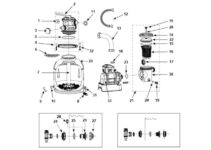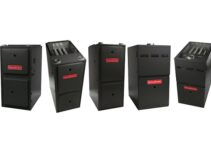Toilets address basic human needs, and they do so with incredible simplicity. They use a simple lever system and gravity to flush human waste and water away. While the toilet design has evolved over the years, the essential parts remain the same.
The Toilet tank is a crucial part of the toilet, and the entire system won’t even function without it. Understanding the different parts of the tank is vital to troubleshooting and fixing prevalent toilet issues.
This guide will provide the diagram of the Kohler toilet tank as a reference while discussing the various functions of the components.
Kohler Toilet Tank Part Diagram
Kohler makes some of the highest-performing and most innovative toilets for customers. These toilets boast extreme performance and durability. However, they come in different types and designs.
The toilet type is defined by the number of pieces that make it up. The tank is one fundamental component in all, irrespective of the design. It houses several other crucial components.
Here’s a diagram of the Kohler toilet tank for reference:

- Fill Valve Assembly
- Float Ball
- Flush Valve Assembly
- Flapper
- Flush Valve Gasket
- Tank to Bowl Gasket- Bolt Kit
- Friction Ring
- Lock Nut
- Tank to Bowl Bolt Kit
- Front Mount Trip Lever
- Bolt Caps
Kohler Toilet Tank Parts Explained
While the toilet’s mechanism is relatively simple, several parts are involved in the process. The toilet tank houses some of the most crucial components, as shown in the diagram. Many filling parts, valves, and water pressure are in the toilet tank.
The toilet tank is the toilet’s upper region, and the toilet handle is attached to it. It usually rests on the top of the toilet bowl. When you flush the toilet, the water that flows is contained in the toilet tank.
Generally, the tank is a solid-state component made of porcelain. It rarely becomes defective since there are no moving pieces. However, it may break or crack.
What follows are the unique functions of the different components of the toilet tank.
Fill valve
The flush valve assembly includes the fill valve. The ballcock valve, also referred to as the fill valve, is in charge of refilling the tank following a flush and connection to the water supply.
Usually, it remains on until the tank is filled. The fill valve will activate whenever water leaves the tank (when a flapper is leaking) to keep the water level stable.
Flush Valves
The flush valve, as the name implies, is a part of the toilet tank responsible for flushing out the toilet’s contents. It flushes them out into the sewer system/septic system via a drain pipe.
The flush valve is usually located in the middle part of the tank. It’s also connected to the overflow tube; its primary purpose is to flush waste from the toilet bowl easily.
Overflow Tube
The overflow tube is integrated into the flush valve. It extends from the base of the flush valve to the toilet tank. Its function is to prevent or stop water from overflowing the tank. It also allows little water to flow into the toilet bowl and fill it as the tank is filling.
Float Ball
It is a mechanism that allows water to fill the toilet tank while preventing overflow. A ballcock or float valve are other names for the toilet float. It’s a major type of fill valve. The water intake can be opened and shut using a lever attached to the float, and the float rises as the tank’s water level rises.
When the float reaches a predetermined level, a mechanism causes the lever to slam the valve shut, cutting off the water supply. When you notice the toilet water running without stopping or stops unexpectedly, there may be a problem with the float ball.
Tank O-Ring Seal
Also known as the tank-to-bowl gasket or the mack washer, this component is a sizable O-shaped gasket or rubber that fits between the top of the toilet bowl and the bottom of the tank. The role of this component is to prevent water from escaping or leaking out of the tank.
When you notice the toilet is leaking above the bowl, significantly below the tank, it could be that the O-ring seal is defective or not correctly installed. The best bet will be to remove the tank and replace the component with a new one.
Flapper
The toilet tank flapper is a rubber stopper. It’s located on the inside base of the tank. The flapper lifts and regularly closes at intervals to pass water into the bowl.
Generally, the flapper is controlled by a level inside the toilet tank through the chain. It allows water to pass inside the bowl. Afterward, it falls back to its original position. It seals the hole at the tank base, similar to a rubber stopper in the bathtub.
However, the flapper usually runs into trouble. It can become hardened and loses its seal after some years. The result of a defective flapper is leaking toilets.

![Genie Garage Door Opener Status Light Blinking [FIXED] Genie Garage Door Opener Status Light Blinking [FIXED]](https://techevery.net/wp-content/uploads/2023/01/genie-garage-door-opener-status-light-blinking-211x150.jpg)

